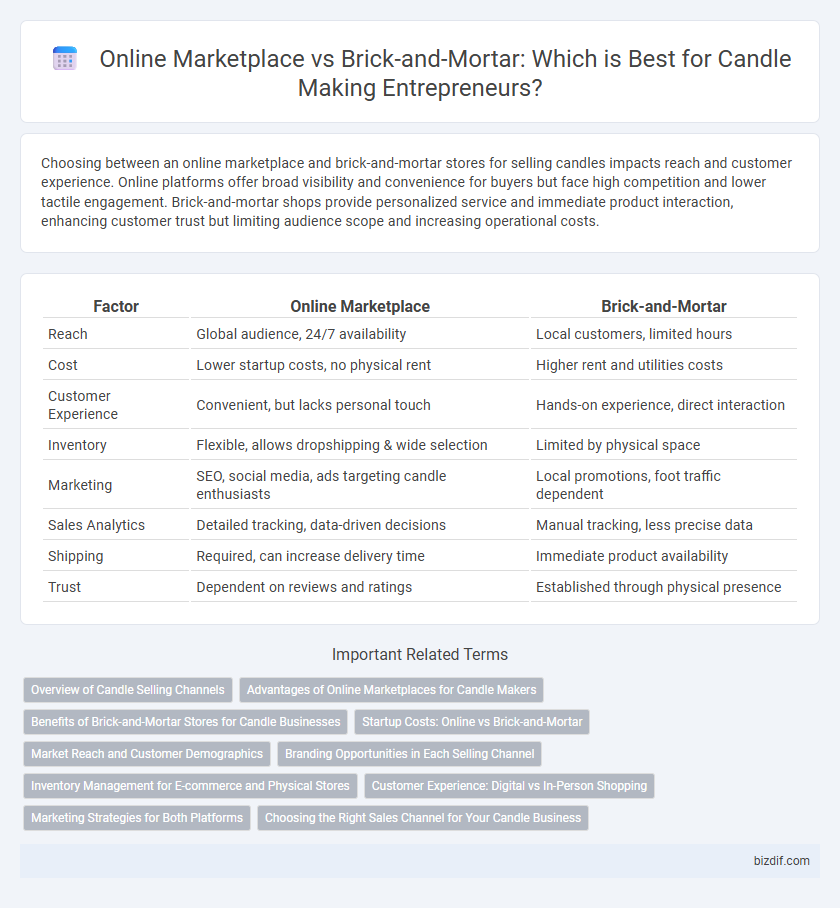Choosing between an online marketplace and brick-and-mortar stores for selling candles impacts reach and customer experience. Online platforms offer broad visibility and convenience for buyers but face high competition and lower tactile engagement. Brick-and-mortar shops provide personalized service and immediate product interaction, enhancing customer trust but limiting audience scope and increasing operational costs.
Table of Comparison
| Factor | Online Marketplace | Brick-and-Mortar |
|---|---|---|
| Reach | Global audience, 24/7 availability | Local customers, limited hours |
| Cost | Lower startup costs, no physical rent | Higher rent and utilities costs |
| Customer Experience | Convenient, but lacks personal touch | Hands-on experience, direct interaction |
| Inventory | Flexible, allows dropshipping & wide selection | Limited by physical space |
| Marketing | SEO, social media, ads targeting candle enthusiasts | Local promotions, foot traffic dependent |
| Sales Analytics | Detailed tracking, data-driven decisions | Manual tracking, less precise data |
| Shipping | Required, can increase delivery time | Immediate product availability |
| Trust | Dependent on reviews and ratings | Established through physical presence |
Overview of Candle Selling Channels
Online marketplaces offer candle makers broader reach, leveraging platforms like Etsy and Amazon to access diverse, global customers with lower overhead costs compared to brick-and-mortar stores. Physical shops enable tactile customer experiences, allowing buyers to smell fragrances and examine candles directly, often fostering local brand loyalty and instant purchases. Combining both channels maximizes visibility and sales potential, balancing digital convenience with personal engagement.
Advantages of Online Marketplaces for Candle Makers
Online marketplaces offer candle makers expansive reach, connecting with a global customer base beyond the limitations of local foot traffic in brick-and-mortar stores. They provide cost-effective selling platforms by minimizing overhead expenses such as rent and utilities, allowing artisans to price products competitively and increase profit margins. Enhanced marketing tools including search engine optimization and customer reviews empower candle makers to build brand recognition and trust efficiently in a digital environment.
Benefits of Brick-and-Mortar Stores for Candle Businesses
Brick-and-mortar stores offer candle businesses tactile customer experiences, allowing buyers to smell scents, assess candle quality, and see colors in person, fostering stronger buyer trust and satisfaction. These physical locations create immediate brand presence and local community engagement, which can boost repeat business and word-of-mouth referrals. Direct interactions enable personalized customer service and on-the-spot feedback, critical for refining candle collections and enhancing product appeal.
Startup Costs: Online vs Brick-and-Mortar
Starting a candle making business online requires significantly lower startup costs compared to a brick-and-mortar store, eliminating expenses like rent, utilities, and in-store staff. Online marketplaces also reduce inventory risks through drop shipping or made-to-order models, minimizing upfront investment in raw materials like wax, wicks, and scents. Brick-and-mortar shops, however, demand substantial initial capital for physical space, decor, and local marketing, which can be a barrier for new candle makers entering the market.
Market Reach and Customer Demographics
Online marketplaces expand candle makers' market reach globally, attracting diverse customer demographics that include younger, tech-savvy consumers seeking unique, artisanal products. Brick-and-mortar stores typically serve localized communities with customers who prioritize tactile experiences and immediate purchase options. Leveraging both channels allows candle businesses to maximize exposure and cater to varied buyer preferences effectively.
Branding Opportunities in Each Selling Channel
Online marketplaces offer candle makers expansive branding opportunities through enhanced digital visibility, access to diverse customer demographics, and data-driven marketing tools that optimize product presentation and customer engagement. Brick-and-mortar stores provide tangible branding experiences with physical displays, in-person customer interactions, and localized brand loyalty fostered through sensory engagement like scent and texture. Leveraging unique strengths of each channel allows candle makers to build a cohesive and memorable brand identity that resonates with both online and offline consumers.
Inventory Management for E-commerce and Physical Stores
Inventory management in online marketplaces leverages real-time tracking systems and automated updates to handle fluctuating demands efficiently, reducing stockouts and overstocks. Brick-and-mortar stores depend on manual counts and in-store monitoring, often facing challenges in synchronizing inventory with sales. E-commerce platforms benefit from integrated software tools that connect sales channels directly to warehouse stock, streamlining restocking processes and improving order fulfillment speed.
Customer Experience: Digital vs In-Person Shopping
Online marketplaces for candle making offer a vast selection with detailed product descriptions, customer reviews, and easy price comparisons, enhancing convenience and informed decision-making. Brick-and-mortar stores provide tactile experiences, allowing customers to smell scents, inspect quality, and receive personalized advice, which fosters trust and sensory engagement. The digital shopping experience emphasizes efficiency and variety, while in-person shopping prioritizes sensory interaction and personalized customer service.
Marketing Strategies for Both Platforms
Online marketplaces for candle making leverage targeted digital advertising, SEO optimization, and influencer collaborations to reach broader, niche audiences efficiently. Brick-and-mortar stores emphasize in-store experiences, local events, and community engagement to build brand loyalty and encourage repeat purchases. Integrating social media campaigns with physical promotions enhances visibility and customer interaction across both platforms.
Choosing the Right Sales Channel for Your Candle Business
Selecting the ideal sales channel for your candle business requires weighing the accessibility and lower overhead costs of online marketplaces against the tangible customer experience and local presence offered by brick-and-mortar stores. Online platforms such as Etsy and Amazon provide expansive reach and detailed customer analytics, while physical retail spaces facilitate sensory engagement critical for candle products with unique scents and textures. Balancing digital convenience with in-person interaction enhances brand visibility and drives targeted sales growth.
Online marketplace vs Brick-and-mortar Infographic

 bizdif.com
bizdif.com